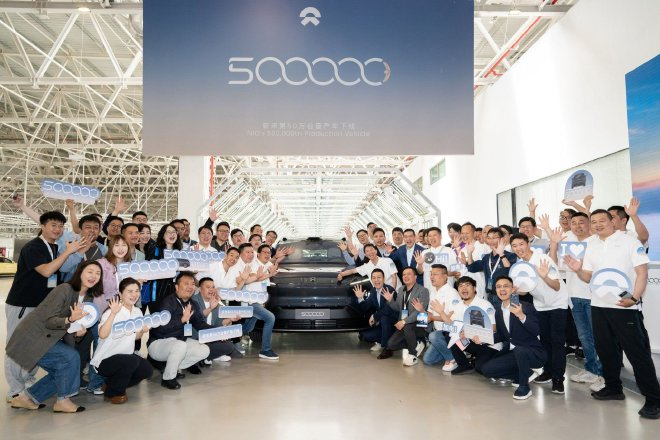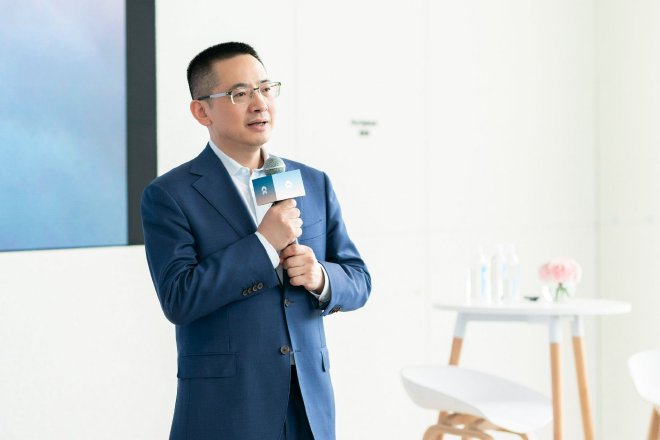On May 9, 2024, NIO’s 500,000th production car rolled off the line at NIO’s second factory in the Xinqiao Intelligent Electric Vehicle Industrial Park in Hefei, Anhui. The new ES8 was the model. At the ceremony, NIO’s Chairman and CEO, Li Bin, announced that NIO’s second brand, Ledeo Auto, will hold a brand launch event on May 15, International Family Day. The Ledeo brand focuses on the family car market, with the brand name meaning “family happiness, home management skills.”
NIO’s 500,000th production car, a new ES8 in Antarctic Blue, was received by the Chairman of iFlytek, Liu Qingfeng. He praised the performance of the new ES8, calling it the “Blue Lightning,” and looks forward to a new travel experience with this car. NIO’s founder, Chairman, and CEO, Li Bin, stated, “500,000 units is a new starting point. We will continue to invest in research and development and charging infrastructure, aiming to maintain NIO’s leading position in the high-end intelligent electric vehicle market through innovative technology, excellent products, and exceptional user experience that exceeds expectations.” NIO’s Coming of Age “What does 500,000 cars mean? For an automaker, it signifies a coming of age,” Liu Qingfeng described the significance of reaching the milestone of 500,000 production cars.
Behind the production of 500,000 vehicles is NIO’s research and development investment of over 43 billion yuan over the past 10 years. According to Fu Bingfeng, Executive Vice President and Secretary General of the China Association of Automobile Manufacturers, NIO, as a representative of China’s high-end new energy vehicle brand, has always adhered to the concept of originality and independent research and development, continuously launching high-quality, high-performance smart electric vehicle products, competing with foreign luxury brands on the same stage, and achieving a leading market share in the high-end pure electric vehicle market, which is very inspiring. Since the first NIO ES8 rolled off the production line on May 27, 2018, NIO has experienced moments of delivering over 20,000 vehicles per month, as well as the darkest moment of “over 40 billion yuan in losses in 4 years”. However, with the flexible service of BaaS battery leasing and the refueling-like experience of battery swapping, coupled with high-quality service and charging-swapping network support, NIO has recently seen a new wave of soaring sales. Perhaps, this is the baptism that adults must go through. The launch of the Lixiang brand and the upcoming first model to compete with the Model Y – the Lixiang L60, are like rainbows after the storm. From 1 to 100, it begins. In the interview after the offline ceremony, Li Bin shared his understanding of the market and NIO’s positioning of its three brands. In the plan, NIO, Lixiang, and Firefly brands correspond to the high-end market of over 300,000 yuan (41550$), the mainstream mass market of over 200,000 yuan (27700$), and the entry-level market of over 100,000 yuan (13850$).
As a high-end brand, NIO’s core is “around technology, products, services, community, with original spirit, full experience.” NIO must “dare to be the first in the world,” strive to do difficult things, like building a charging and swapping system. It is this gradually improving charging and swapping system that supports NIO’s high-end brand positioning and attracts 6 allies from the swapping alliance. “Long-term persistence pays off, with 500,000 users choosing NIO, which proves this.” Based on the relatively complete charging and swapping system, NIO co-founder and president Qin Lihong confidently said “LeDao is truly mature,” boldly stating “who had a thousand swapping stations waiting for it when the brand launched its first car.” In Li Bin’s view, the release of ET9 marks NIO “basically completing from 0 to 1” in the past decade, while LeDao’s release is NIO “starting a new process from 1 to 10, from 1 to 100.” Bigger market In Li Bin’s view, for LeDao to enter the larger mainstream market, the ability to compete should not be simply “calling it cost-effective,” but balancing between experience value and cost. Unlike NIO, LeDao’s strategy should “dare to be the first in the world,” and “provide mature technology and services with more cost-effective solutions for our users.” Qin Lihong’s statement about the “maturity of the full chain end-to-end experience” comes from NIO’s accumulation and investment over the past decade, and Li Bin also answered the question about LeDao’s advantages from this perspective. LeDao car is defined based on NIO’s research and development achievements, and NIO’s services, charging and swapping system capabilities, so Li Bin said LeDao’s “advantages are definitely very significant.”
Regarding the impact of LeDao on NIO and the issue of internal strife, Li Bin believes that the competition in the price range of over 200,000 is already very intense. Brand stratification is important and inevitable. About the opening of the battery swapping alliance and stations, Li Bin said it is a long-term strategy, similar to the development of cloud services. NIO was ready to open the battery swapping system from the first day, but it requires consensus. Only when NIO reaches a certain scale, joining the NIO swapping standard will be a rational choice. Li Bin stated that internal openness must come first before external openness. NIO will use three different sizes, voltage platforms, and capacities of battery packs for its three brands. Battery swapping also involves complex legal relationships such as battery procurement and asset management. Li Bin now believes that they have clarified these issues, and only need to unify product planning and battery pack standards, saving alliance members time and planning costs, while addressing the pain point of many users unable to install private chargers. Future Beyond If NIO’s battery swapping system has become the de facto standard, then intelligence may be a “never-ending competition,” Li Bin said. NIO’s investment in intelligence is resolute. Li Bin believes that starting from 2015, adhering to the full-stack self-research approach will have significant advantages in experience and iteration speed. Although the start may be slower and the cost higher, once this system is established, the subsequent advantages will be enormous. Meanwhile, with the entry of Huawei and Xiaomi, the industry has brought new variables. Li Bin believes that the entry of phone manufacturers will accelerate the process of transitioning from oil to electricity and increase the penetration rate of new energy vehicles. While NIO feels the pressure, they also need to learn from what they do well. The automotive industry, as a very long chain, will ultimately be won by comprehensive capabilities. In his view, electrification and intelligence cannot be simply divided into halves. The automotive industry is a long-term competition, a “marathon on a muddy road.” The electrification and intelligence are just one round of the competition. Today’s result is whether they can stay in the market after 2025, and there is no trick for car companies.
Qin Lihong also expressed NIO’s long-termism from a marketing perspective. “From single model to multiple models, from single brand to multiple brands, from single market to multiple countries, these are all dimensions that require continuous learning. The only thing that hasn’t changed in recent years is that we have always been changing.”




